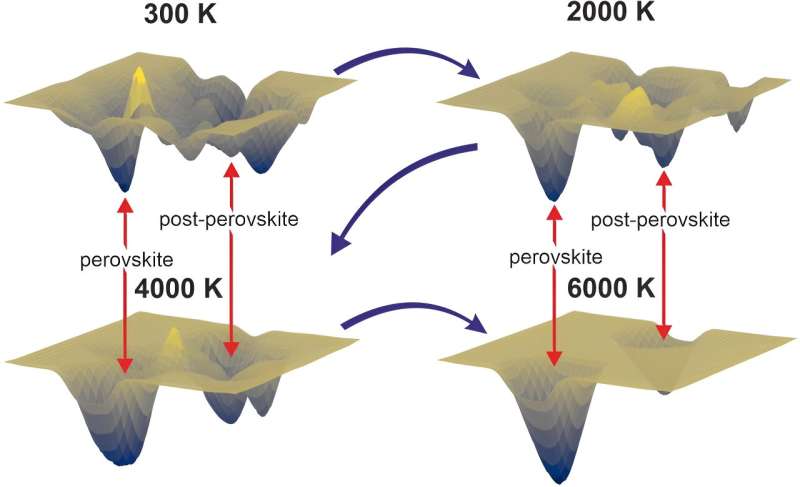This article has been reviewed according to Science X's editorial process and policies. Editors have highlighted the following attributes while ensuring the content's credibility:
fact-checked
trusted source
proofread
New method removes roadblock in crystal structure prediction, probes Earth's interior

Researchers from Skoltech, MIPT, and Dukhov Research Institute of Automatics have proposed a method that cuts all the right corners to spare computational costs and enable the prediction of material structures at any temperatures. The team reports its findings for the structure of iron in the inner core and magnesium silicate in the Earth's lower mantle.
The results refine the existing picture. Using the conventional approach, such calculations for any nonzero temperature would have been prohibitively expensive due to the amount of supercomputing time required. Published in npj Computational Materials, the new method can now also be used to explore other materials .
"Before this study, it was possible to predict how a given set of atoms will be arranged in space at a certain pressure, but searching for the right structure could only be done at the absolute zero of temperature, which is of course very different from what you'd expect within the Earth," the principal investigator of the study, Professor Artem R. Oganov of Skoltech, commented.
The reason why it was so difficult to account for nonzero temperatures was that a great many atomic configurations brought about by thermal vibrations would have to be included in the computation. This would drive computational costs through the roof, yet it was the only way to determine the stability of all the theoretically possible crystal structures and thus identify which of them would actually occur under real-world conditions.
The authors of the study found a way to radically reduce the computational costs of solving this problem without compromising prediction quality. And they used their technique to contribute to two ongoing planetary science debates: What is the exact structure that the iron atoms adopt in the Earth's core? And where exactly in the lower mantle does magnesium silicate go from one phase to another? These unsettled issues have implications for the long-term temperature evolution of the planet.
"By refining the phase diagrams of magnesium silicate and iron, we confirm, firstly, that iron should have a so-called hexagonal close-packed crystal structure within the solid inner core of the Earth. That said, the calculation assumes pure iron in the core, neglecting the impurities that have to be considered in future research. And secondly, we have refined the phase transition boundary for magnesium silicate that is dominant in the Earth's mantle. That, combined with seismological data, allows us to gauge the temperature distribution in the mantle of our planet," Oganov said.
The new computationally superior method rests on three pillars that enable high-quality results at moderate computational costs. First, the extremely challenging quantum mechanical computations are replaced with so-called machine learning potentials. These are far easier to calculate and almost as accurate.
Second, the new method's creators used the thermodynamic perturbation theory to upgrade their "almost as accurate" results to those truly equivalent to quantum mechanical calculations at a modest additional computational cost.
Third, certain aspects of the prediction for nonzero temperatures proved computationally favorable: Namely, one of the reasons stable crystal structures are hard to predict is the extremely large number of possibilities corresponding to the system's local energy minima (stable configurations by definition have the lowest energies possible). But the higher the temperature, the fewer such local energy minima exist, making the calculations easier.
Besides iron and magnesium silicate, the team has also tested its technique on aluminum, tungsten boride, and hafnium dioxide, and expects the new approach to bring results when applied to other materials, too.
More information: Ivan A. Kruglov et al, Crystal structure prediction at finite temperatures, npj Computational Materials (2023). DOI: 10.1038/s41524-023-01120-6
Provided by Skolkovo Institute of Science and Technology
















